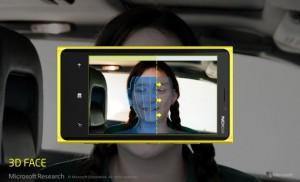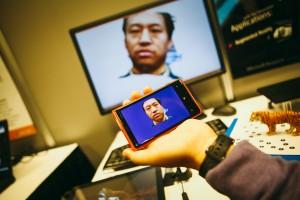With 3d printers creeping their ways into thousands of new homes every month, such technology is bringing forth a variety of possible new applications for all sorts of technology. In order to take advantage of this trend  within the 3D printing market, researchers at Microsoft are looking into making their Windows smartphones capable of becoming 3D face scanners. They are doing this by using only the camera that comes with a typical phone as the data collection device.
within the 3D printing market, researchers at Microsoft are looking into making their Windows smartphones capable of becoming 3D face scanners. They are doing this by using only the camera that comes with a typical phone as the data collection device.
The research Microsoft has been doing seems to differ from the technology used in most 3D scanners on the market today. Instead of relying on multiple sensors to calculate distance for accurate 3D models, Microsoft uses a plain old smartphone camera and some pretty sophisticated software algorithms. The tricky part for researchers was trying to make a user interface which was intuitive, as well as simple for anyone to use. If this 3D Reconstruction technology didn’t seem advanced enough already, than maybe the name of the user interface, which was named after the self-aware artificial intelligence system in the Terminator movies, “Skynet,” will do the trick.
Skynet UI works by allowing users to act almost as if they are taking a panoramic photograph with their phone. Instead of using themselves as the rotational pivot point, like a user would do when taking a panoramic photo, they use another person’s face as that point. The software gives the person scanning, cues of when to move the camera around the scannee’s head. In the meantime it captures  image data and reconstructs it into a 3D rendering. The video at the bottom of this page will show you just how intuitive it is.
image data and reconstructs it into a 3D rendering. The video at the bottom of this page will show you just how intuitive it is.
Once a person’s face is scanned, a smartphone user can rotate the face on their phone in any direction. They can then send the file to a 3D printer and print out a 3D representation of that person.
This research comes on the heals of similar research on a project called “Tango” being done by Google. Google seeks to make smartphones 3d image capturing devices for a user’s surrounding environment. Unlike Google’s Project Tango, which uses several new sensors, and can scan entire rooms, Skynet UI is currently created for facial scanning, and uses just a simple smartphone camera. It will be very interesting to see where Microsoft takes this technology, as currently there are not a tremendous amount of applications for its use. Like any new advanced technology which comes to market, interesting applications to take advantage of this technology will surely come about. Discuss Microsoft’s Skynet UI at 3dprintboard, and be sure to check out the video below.
Subscribe to Our Email Newsletter
Stay up-to-date on all the latest news from the 3D printing industry and receive information and offers from third party vendors.
You May Also Like
Profiling a Construction 3D Printing Pioneer: US Army Corps of Engineers’ Megan Kreiger
The world of construction 3D printing is still so new that the true experts can probably be counted on two hands. Among them is Megan Kreiger, Portfolio Manager of Additive...
US Army Corps of Engineers Taps Lincoln Electric & Eaton for Largest 3D Printed US Civil Works Part
The Soo Locks sit on the US-Canadian border, enabling maritime travel between Lake Superior and Lake Huron, from which ships can reach the rest of the Great Lakes. Crafts carrying...
Construction 3D Printing CEO Reflects on Being Female in Construction
Natalie Wadley, CEO of ChangeMaker3D, could hear the words of her daughter sitting next to her resounding in her head. “Mum, MUM, you’ve won!” Wadley had just won the prestigious...
1Print to Commercialize 3D Printed Coastal Resilience Solutions
1Print, a company that specializes in deploying additive construction (AC) for infrastructure projects, has entered an agreement with the University of Miami (UM) to accelerate commercialization of the SEAHIVE shoreline...





























